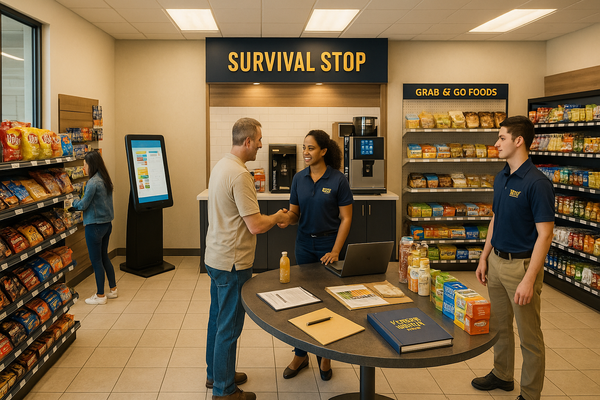Cash Drop Discipline: How Systematic Drop Management Protects Every Dollar in Your Drawer
Most stores treat cash drops casually. Learn how to build a measurable, disciplined system that cuts theft, improves accuracy, and safeguards profit using simple steps every store can follow daily—because measurement protects money.

Stores that implement disciplined cash drop protocols reduce cash variance by 75% and cut internal theft incidents by 60%, according to retail loss prevention research from the National Retail Federation and Loss Prevention Research Council. Yet most convenience stores still treat cash drops as an informal, inconsistent process rather than the structured financial safeguard it should be.
The cost of this neglect reveals itself slowly. A store with lax drop procedures loses $50 here, $100 there, until year-end audits uncover $3,000 in unexplained shrinkage. When cash handling lacks clarity, losses stack silently while theft becomes invisible. The difference between stores that protect every dollar and those that leak profit comes down to one principle: measurement creates management.
What Systematic Cash Drop Management Really Means
Cash drop management extends far beyond the simple act of removing bills from a register drawer. True systematic management involves five integrated controls that create an unbroken chain of custody from transaction to deposit.
A complete cash drop system includes precise drop thresholds that define when cash must be removed (typically when bills over $5 denominations exceed $200). It requires dual-verification procedures where two employees count and witness every drop, eliminating later disputes. It demands secure transport protocols using tamper-evident bags with serialized tracking or time-stamped drop safes. It insists on real-time documentation capturing the date, time, amount, and responsible parties for every drop. And it culminates in daily reconciliation that matches drop logs against safe contents and bank deposits within 24 hours, not weeks later.
When properly designed, this system accomplishes four critical objectives simultaneously. It protects against internal theft by creating visible accountability trails. It reduces robbery risk by keeping minimal cash exposed in registers. It improves deposit accuracy through systematic verification. And it generates audit-ready financial records that satisfy insurance underwriters, lenders, and regulatory agencies.
The Five Core Components of High-Integrity Cash Drops
1. Clear Drop Thresholds
Vague guidance like "drop cash when it builds up" creates inconsistent behavior and accountability gaps. Effective threshold policies specify exact triggers: "Drop all bills in denominations of $10 and above when total exceeds $200" or "Perform drops every 1/2 hour during peak periods regardless of amount."
Thresholds should balance risk mitigation (smaller amounts reduce robbery exposure) against operational efficiency (too-frequent drops disrupt customer service). Most successful operators set thresholds between $150 and $400, adjusted for location risk profiles.
2. Dual-Verification Process
Single-person drops create vulnerability to both theft and false accusations. Dual verification requires two employees to count cash together, with both signing the drop log. This simple protocol eliminates "he said/she said" disputes and makes collusion significantly more difficult.
For single-coverage shifts, some stores use cameras positioned to capture drop bag counts, providing video verification when a second employee is unavailable. Smart safe technology automates this by electronically counting and recording bills as they enter the safe.
3. Secure Drop Equipment
The security of drop equipment determines how easily cash can be diverted after leaving the register. Tamper-evident bags with serialized numbers (costing $0.15-0.30 per bag) provide visible evidence if bags are opened before reaching the bank. Traditional drop safes ($300-600) use one-way slots that prevent retrieval without manager override.
Smart safes ($2,500-5,000 per unit) represent the highest security tier, automatically counting bills, recording serial numbers, photographing deposits, and transmitting data to central monitoring systems. For multi-location operators, smart safes reduce both theft risk and manual reconciliation time by 70%, according to industry data.
4. Real-Time Documentation
Documentation delayed is documentation forgotten. Drops logged hours later (or worse, at shift end) create memory gaps and manipulation opportunities. Best-practice protocols require logging before cash enters the drop safe, capturing six essential data points: date, exact time (hour and minute), amount by denomination, employee performing the drop, witness name, and sequential drop number.
Digital log systems, whether through dedicated apps or POS integration, add timestamping, photo capture, and automatic variance alerts that manual logs cannot provide. These systems also eliminate illegible handwriting and lost paper logs that plague many operators.
5. Daily Reconciliation
The gap between cash drop and reconciliation determines how quickly variances surface. Stores that reconcile monthly discover theft or errors weeks after occurrence, when memories fade and evidence disappears. Daily reconciliation (matching drop logs to safe contents to bank deposits) catches discrepancies within hours, when investigation can still identify root causes.
Reconciliation should follow a fixed protocol: count safe contents at day end, match to cumulative drop logs, identify variances exceeding $5, investigate causes immediately, document findings, and adjust procedures if patterns emerge.
Measurement Transforms Management
Peter Drucker's management principle applies perfectly to cash handling: "What gets measured gets managed. Clarity beats charisma. If you can't define success, you can't manage it."
Just as Drucker taught that organizations must measure what matters most, convenience store operators must define cash handling success in precise, measurable terms: drop frequency, variance rates, documentation completeness, and deposit timing. When you measure these consistently, theft becomes visible, errors become correctable, and accountability becomes automatic.
Vague expectations like "be careful with cash" create vague results. Clear metrics like "drop every $200, log every transaction, reconcile daily" create financial discipline.
This mirrors The Office Prodigy's process excellence philosophy: repeatable, measurable routines eliminate ambiguity and build operational trust. When employees know exactly what success looks like, they achieve it reliably. When success remains undefined, performance varies wildly.
The Compounding Benefits of Measurement
Measurement-driven cash drop systems deliver returns across multiple dimensions:
Enhanced theft deterrence: When employees know every drop creates an audit trail linking specific individuals to specific amounts at specific times, opportunistic theft becomes high-risk behavior. Research shows that visible measurement reduces internal theft incidents by 50-60%.
Reduced robbery risk: Maintaining low cash in registers (through frequent drops) reduces both robbery likelihood and loss amounts. Industry data indicates stores with disciplined drop protocols experience 40% fewer robbery attempts, as criminals observe limited cash availability.
Faster variance resolution: Daily reconciliation catches $50 errors before they become $500 mysteries. Stores that reconcile daily report 80% faster resolution times and 65% higher recovery rates on identified discrepancies.
Improved staff confidence: Clear procedures protect innocent employees from false theft accusations. When systems create transparent accountability, good employees feel safer and bad actors face exposure.
Audit-ready records: Insurance claims, bank loan applications, and regulatory compliance all require documented cash handling procedures. Systematic drop management creates these records automatically, reducing audit costs and improving terms for both insurance and financing.
Practical Implementation Strategies
Establish Written Drop Policies
Create a one-page Cash Drop Standard Operating Procedure (SOP) that defines thresholds, verification steps, documentation requirements, and reconciliation timing. Post this visibly in the cash office. Require every employee with cash-handling responsibilities to read, sign, and date acknowledgment. Update annually and whenever procedures change.
Invest in Appropriate Technology
For single-location operators: Start with tamper-evident bags ($50-100 annually) and a basic drop safe ($300-600). Use manual drop logs with carbon copies (one in safe, one with deposit). Total investment: under $700.
For 3-10 location operators: Consider smart safes for highest-volume stores ($2,500-5,000 per unit) paired with traditional safes for lower-volume locations. Centralize drop log review digitally. Estimated cost: $3,000-8,000 per location.
For 10+ location chains: Implement smart safe networks with centralized monitoring dashboards, providing real-time visibility into drop compliance, variance trends, and exception alerts across all sites. Cost: $4,000-6,000 per location with volume discounts.
Train Systematically
Develop a 15-minute training module covering: threshold identification, two-person counting technique, bag sealing procedure, log completion requirements, and safe operation. Use video demonstration for consistency across locations. Retrain annually and when procedures change. Test comprehension through role-play scenarios before authorizing cash-handling privileges.
Audit Regularly
Conduct monthly surprise safe counts comparing logged drops to actual contents. Expect 100% match. Investigate any variance exceeding $5. Document findings and corrective actions. Random audits create powerful theft deterrence, as employees know procedures are verified unpredictably.
Deploy Exception Reporting
For operators with digital systems, configure alerts for: drops overdue (drawer over threshold >30 minutes), unusual drop timing (drops after closing hour), missing documentation (unsigned logs), and variance patterns (same employee consistently off by small amounts).
Exception reporting transforms reactive management ("we found a problem during annual inventory") into proactive prevention ("system flagged unusual activity this morning").
Digitize Progressively
Move from handwritten logs to digital capture as resources allow. Options range from simple tablet-based forms ($200 one-time cost) to full POS integration (typically included in modern systems) to dedicated cash management platforms ($50-150 per location monthly).
Digital logs provide timestamping, photo documentation, automatic variance calculations, trend analysis, and multi-location roll-ups that manual processes cannot match.
Building Discipline Into Daily Operations
Systematic cash drop management is not a one-time project. It is an operational discipline that requires consistency, measurement, and adaptation.
Store owners who implement these protocols report similar transformations. Cash variance drops from hundreds monthly to single-digit discrepancies. Internal theft investigations decline because theft becomes difficult. Bank deposit accuracy improves, eliminating costly corrections and bank fees. And perhaps most importantly, managers stop worrying whether cash makes it safely to the bank, because systems measure and prove it does.
The difference between hoping cash stays safe and knowing it stays safe lies entirely in measurement. Peter Drucker's principle endures because it reflects operational truth: clarity beats charisma. If you can't define cash handling success, you can't protect your profits.
Independent operators who systematize cash drop management gain the same loss prevention strength as major chains. They achieve tighter shrinkage control, cleaner audits, stronger staff accountability, and daily visibility into cash flow accuracy. Most importantly, they transform cash drops from a trust-based procedure into a discipline-based system.
Measurement doesn't hope. It proves. Every single day.
This article is part of the weekly "Profit Power" series from C-Store Thrive.
Found this analysis helpful? Share C-Store Thrive with fellow convenience store owners who want to make every dollar count because profit protection starts with measuring what matters most.





